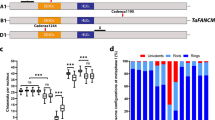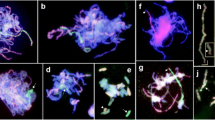Abstract
Key message
Terminal deletions obligate the first crossover to be formed in more proximal positions. This increases the recombination rate in intercalary intervals but not in the proximity of the centromere.
Abstract
Crossovers are not uniformly distributed along chromosomes in wheat. They take place preferentially in distal positions. The effect of the chromosomal architecture on crossover positioning has been analyzed from the chiasmate bonds at metaphase I formed by the truncated arms of 51 terminal deletion lines of eight wheat chromosomes. Chromosome 4A and the B genome chromosomes, in their standard or truncated conformation, and their arms, were identified by C-banding. Chromosomes studied show a similar chiasma distribution. Reduction of the size of the truncated arms is accompanied by a gradual decrease of the chiasma frequency in chromosome arms 1BL, 3BS, 3BL, 4BL, 5BS, 5BL, 6BL, 7BS, 7BL and 4AL. In chromosome arm 1BS, most chiasmata are concentrated in the distal half of the satellite and, in 4AS, in the distal 24 %. The arms 2BS, 2BL and 6BS do not show a simple decreasing gradient of the recombination rate, the chiasma frequency increases in subdistal intervals compared to more distal regions. Although terminal deletions usually induce an increase of chiasma frequency in intercalary regions, the level of intact chromosome arms is maintained in only a few deletion lines. Truncated arms containing only the 20 % proximal of the intact arm do not form chiasmata. The relationships of chiasma positioning with chromatin structure and genome organization is discussed.


Similar content being viewed by others
References
Akhunov ED, Goodyear AW, Geng S, Qi LL, Echalier B et al (2003a) The organization and rate of evolution of wheat genomes are correlated with recombination rates along chromosome arms. Genome Res 13:753–763
Akhunov ED, Akhunova AR, Linkiewicz AM, Dubkovski J, Hummel D et al (2003b) Synteny perturbations between wheat homoeologous chromosomes by locus duplications and deletions correlate with recombination rates along chromosome arms. PNAS 100:10836–10841
Albini SM, Jones GH (1988) Synaptonemal complex spreading in Allium cepa and Allium fistulosum. II. Pachytene observations: the SC karyotype and the correspondence of late recombination nodules and chiasmata. Genome 30:399–410
Anderson LK, Doyle GG, Brigham B, Carter J, Hooker KD et al (2003) High-resolution crossover maps for each bivalent of Zea mays using recombination nodules. Genetics 165:849–865
Anderson LK, Salameh N, Bass HW, Harper LC, Cande WZ et al (2004) Integrating genetic linkage maps with pachytene chromosome structure in maize. Genetics 166:1923–1933
Bassi FM, Kumar A, Zhang Q, Paux E, Huttner E et al (2013) Radiation hybrid QTL mapping of Tdes2 involved in the first meiotic division of wheat. Theor Appl Genet 126:1977–1990
Choulet F, Alberti A, Theil S, Glover N, Barbe V et al (2014) Structural and functional partitioning of bread wheat chromosome 3B. Science 345:1249721
Curtis CA, Lukaszewski AJ, Chrzastek M (1991) Metaphase-I pairing of deficient chromosomes and genetic mapping of deficiency breakpoints in wheat. Genome 34:553–560
Darlington CD (1935) The internal mechanics of the chromosomes II. Prophase paring at meiosis in Fritillaria. Proc Roy Soc Lond B 118:59–73
Drouaud J, Camilleri C, Bourguignon PY, Canaguier A, Berard A et al (2006) Variation in crossing-over rates across chromosome 4 of Arabidopsis thaliana reveals the presence of meiotic recombination ‘‘hot spots’’. Genome Res 16:106–114
Endo TR, Gill BS (1996) The deletion stocks of common wheat. J Hered 87:295–307
Erayman M, Sandhu D, Sidhu D, Dilbirligi M, Baenziger PS, Gill KS (2004) Demarcating the gene-rich regions of the wheat genome. Nucleic Acids Res 32:3546–3565
Fogwill M (1958) Differences in crossing over and chromosome size in the sex cells of Lilium and Fritillaria. Chromosoma 9:493–504
Gaut BS, Wright SI, Rizzon C, Dvorak J, Anderson LK (2007) Recombination: an underappreciated factor in the evolution of plant genomes. Nat Rev Genet 8:77–84
Gill KS, Gill BS, Endo TR, Mukai Y (1993) Fine physical mapping of Ph1, a chromosome pairing regulator gene in polyploid wheat. Genetics 134:1231–1236
Giráldez R, Cermeño MC, Orellana J (1979) Comparison of C-banding pattern in the chromosomes of inbred lines and open pollinated varieties of rye. Z Pflanzenzuecht 83:40–48
Harper L, Golubovskaya I, Cande WZ (2004) A bouquet of chromosomes. J Cell Sci 117:4025–4032
Higgins JD, Perry RM, Barakate A, Ramsay L, Waugh R et al (2012) Spatiotemporal asymmetry of the meiotic program underlies the predominantly distal distribution of meiotic crossovers in barley. Plant Cell 24:4096–4109
Higgins JD, Osman K, Jones GH, Franklin FCH (2014) Factors underlying restricted crossover localization in barley meiosis. Annu Rev Genet 48:29–47
Holm PB (1986) Chromosome pairing and chiasma formation in allohexaploid wheat: Triticum aestivum analyzed by spreading of meiotic nuclei. Carlsberg Res Commun 51:239–294
Jensen-Seaman MI, Furey TS, Payseur BA, Lu Y, Roskin KM et al (2004) Comparative recombination rates in the rat, mouse, and human genomes. Genome Res 14:528–538
Jones GH, Franklin FCH (2006) Meiotic crossing-over: obligation and interference. Cell 126:246–248
Jones LE, Rybka K, Lukaszewski AJ (2002) The effect of a deficiency and a deletion on recombination in chromosome 1BL in wheat. Theor Appl Genet 104:1204–1208
Keeney S, Giroux CN, Kleckner N (1997) Meiosis-specific DNA double-strand breaks are catalyzed by Spo11, a member of a widely conserved protein family. Cell 88:375–384
Kempana C, Riley R (1962) Relationships between the genetic effects of deficiencies for chromosomes III and V on meiotic pairing in Triticum aestivum. Nature 195:1270–1273
Künzel G, Waugh R (2002) Integration of microsatellite markers into the translocation-based physical RFLP map of barley chromosome 3H. Theor Appl Genet 105:660–665
Künzel G, Korzun L, Meister A (2000) Cytologically integrated physical restriction fragment length polymorphism maps for the barley genome based on translocation breakpoints. Genetics 154:397–712
Lukaszewski AJ (2008) Unexpected behaviour of an inverted rye chromosome arm in wheat. Chromosoma 117:569–578
Lukaszewski AJ, Curtis CA (1993) Physical distribution of recombination in B-genome chromosomes of tetraploid wheat. Theor Appl Genet 86:121–127
Lukaszewski AJ, Kopecky D, Linc G (2012) Inversions of chromosome arms 4AL and 2BS in wheat invert the patterns of chiasma distribution. Chromosoma 121:201–208
Luo MC, Deal KR, Akhunov ED, Akhunova AR, Anderson OD et al (2009) Genome comparisons reveal a dominant mechanism of chromosome number reduction in grasses and accelerated genome evolution in Triticeae. PNAS 106:15780–15785
Martínez M, Cuñado N, Carcelén N, Romero C (2001) The Ph1 and Ph2 loci play different roles in the synaptic behaviour of hexaploid wheat Triticum aestivum. Theor Appl Genet 103:398–405
Mayer KFX, Martis M, Hedley PE, Simkova H, Liu H et al (2011) Unlocking the barley genome by chromosomal and comparative genomics. Plant Cell 23:1249–1263
Naranjo T (2014) Dynamics of rye telomeres in a wheat background during early meiosis. Cytogenet Genome Res 143:60–68
Naranjo T, Roca A, Goicoechea PG, Giráldez R (1987) Arm homoeology of wheat and rye chromosomes. Genome 29:873–882
Naranjo T, Valenzuela NT, Perera E (2010) Chiasma frequency is region-specific and chromosome conformation-dependent in a rye chromosome added to wheat. Cytogenet Genome Res 129:133–142
Newton WCF, Darlington CD (1930) Fritillaria meleagris chiasma formation and distribution. J Genet 22:1–14
Qi LL, Friebe B, Gill BS (2002) A strategy for enhancing recombination in proximal regions of chromosomes. Chromosome Res 10:645–654
Saintenac C, Falque M, Martin OC, Paux E, Feuillet C, Sourdille P (2009) Detailed recombination studies along chromosome 3B provide new insights on crossover distribution in wheat (Triticum aestivum L.). Genetics 181:393–403
Sallee PJ, Kimber G (1978) An analysis of the pairing of wheat telocentric chromosomes. In: Ramanujan S (ed) Proceedings of 5th International Wheat Genet Symposium, New Dehli, India, pp 408–419
Scherthan H (2001) A bouquet makes ends meet. Nat Rev Mol Cell Biol 2:621–627
Sears ER (1954) The aneuploids of common wheat. Mo Agric Exp Stn Res Bull 572:58
Sears ER (1984) Mutations in wheat that raise the level of meiotic chromosome pairing. In: Gustafson JP (ed) Gene manipulation in plant improvement. In: Proceedings of 16th Stadler Genet Symposium. Plenum Press, New York, pp 295–300
See DR, Brooks S, Nelson JC, Brown-Guedira G, Friebe B, Gill BS (2006) Gene evolution at the ends of wheat chromosomes. PNAS 103:4162–4167
Valenzuela NT, Perera E, Naranjo T (2012) Dynamics of rye chromosome 1R regions with high and low crossover frequency in homology search and synapsis development. PLoS One 7(4):e36385. doi:10.1371/journal.pone.0036385
Wu J, Mizuno H, Hayashi-Tsugane M, Ito Y, Chiden Y et al (2003) Physical maps and recombination frequency of six rice chromosomes. Plant J 36:720–730
Acknowledgments
This work was supported by grant AGL2012-38852 from Dirección General de Investigación Cientifíca y Técnica, Ministerio de Economía y Competitividad of Spain. I would like to thank T. R. Endo and the National BioResource Project-Wheat, Japan, for kindly supplying the deletion stocks, and to E Perera for her technical assistance.
Conflict of interest
The author declares that he has no conflict of interest.
Ethical standard
The author states that the experiments comply with the current laws in Spain where they were performed.
Author information
Authors and Affiliations
Corresponding author
Additional information
Communicated by S. S. Xu.
Electronic supplementary material
Below is the link to the electronic supplementary material.
Rights and permissions
About this article
Cite this article
Naranjo, T. Forcing the shift of the crossover site to proximal regions in wheat chromosomes. Theor Appl Genet 128, 1855–1863 (2015). https://doi.org/10.1007/s00122-015-2552-7
Received:
Accepted:
Published:
Issue Date:
DOI: https://doi.org/10.1007/s00122-015-2552-7




